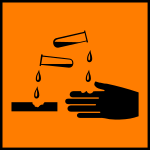Corrosive substances
Corrosive substances destroy living tissue or attack surfaces, i. that is, they show a corrosive effect . Corrosive substances include stronger acids and bases as well as compounds that react strongly alkaline or acidic with water. Also oxidizing action and dehydrating agents can be caustic. Corrosive substances can be organic or inorganic in nature, solid , liquid or gaseous .
Examples: hydrochloric acid , sulfuric acid , nitric acid , caustic soda , concentrated soapy water , drain cleaner .
Corrosive gases (e.g. chlorine , fluorine ) cause damage to the respiratory tract and lungs, even in the smallest amounts and in low concentrations.
Liquids have an immediate effect on the skin because of their wetting effect and are therefore the most dangerous for them. Solid and gaseous corrosive substances have to linger on the tissue of the skin for a while in order to be able to react with externally adhering moisture or the internal tissue fluid. See also chemical burns .
Classification according to GHS / CLP

According to the CLP Regulation (Appendix 1, Part 3, Table 3.2.1) and the GHS Directive , the following categories must be used
- Corrosive to the skin
- Skin corrosive 1A: Corrosive effect on the skin within 3 minutes
- Skin corrosive 1B: Corrosive effect on the skin after 3 minutes to 1 hour
- Skin corrosive 1C: Corrosive effect on the skin after 1 hour to 4 hours
In contrast to the Substances Directive, substances with irreversible eye damage are marked with this pictogram
- Serious eye damage / eye irritation
- Category 1: irreversible damage to the eye
Metal corrosive properties are also recorded under CLP / GHS. However, this represents a physical / chemical hazard and not a toxic hazard.
- Corrosive to metals
- Cat 1: Corrosive to metals
Classification according to dangerous goods regulations
The classification according to dangerous goods directives is as follows
- Hazard class 8
- Packing group I: Skin corrosion within 3 minutes
- Packing group II: Skin corrosion after 3 minutes to 1 hour
- Packing group III: Skin corrosion after 1 hour to 4 hours
- Packing group III: Metal corrosive substances
Goods that have the properties of irreversible effects on the eyes do not meet the criteria for classification in hazard class 8.
Classification according to the substance directive (outdated)
Before 2015, according to Directive 67/548 / EEC (substance directive ), corrosive substances and preparations were assigned according to the following criteria:
- Hazard description C - Corrosive
- R34 - Causes severe burns: When applied to healthy skin, the skin tissue is destroyed in its entire thickness after an exposure time of no more than 3 minutes.
- R35 - Causes burns: When applied to healthy skin, the entire thickness of the skin tissue is destroyed after an exposure time of 4 hours.
- R35 - Causes burns: organic peroxides
Metal corrosive substances were not covered by the substance directive.
See also
- Etching as a manufacturing process
- Irritating substances
- Toxic substances
swell
- Germany: ChemPrüfV § 2 Abs. 4

